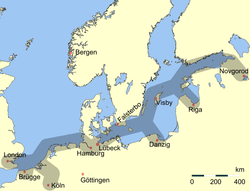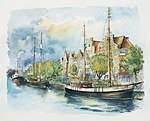Zwolle
Zwolle (Dutch: [ˈzʋɔlə] (![]()
Zwolle | |
|---|---|
City and municipality | |
  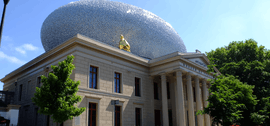  .jpg) Images, from top down, left to right: Sassenstraat, Grote Markt, Museum de Fundatie, Luttekestraat, and the Binnenstad | |
 Flag  Coat of arms | |
.svg.png) Location in Overijssel | |
| Coordinates: 52°31′N 6°6′E | |
| Country | Netherlands |
| Province | |
| Government | |
| • Body | Municipal council |
| • Mayor | Peter Snijders (VVD) |
| Area | |
| • Municipality | 119.36 km2 (46.09 sq mi) |
| • Land | 111.38 km2 (43.00 sq mi) |
| • Water | 7.98 km2 (3.08 sq mi) |
| Elevation | 4 m (13 ft) |
| Population | |
| • Municipality | 127,497 |
| • Density | 1,145/km2 (2,970/sq mi) |
| • Urban | 123,507 |
| • Metro | 181,440 |
| Demonym(s) | Zwollenaar |
| Time zone | UTC+1 (CET) |
| • Summer (DST) | UTC+2 (CEST) |
| Postcode | 8000–8049 |
| Area code | 038 |
| Website | www |
History
| Year | Pop. | ±% p.a. |
|---|---|---|
| 1404 | 3,500 | — |
| 1525 | 4,500 | +0.21% |
| 1599 | 6,500 | +0.50% |
| 1628 | 7,700 | +0.59% |
| 1670 | 10,932 | +0.84% |
| 1675 | 6,963 | −8.63% |
| 1680 | 9,388 | +6.16% |
| 1682 | 7,800 | −8.85% |
| 1748 | 11,931 | +0.65% |
| 1795 | 12,220 | +0.05% |
| Source: Lourens & Lucassen 1997, pp. 83–84 | ||
Archaeological findings indicate that the area surrounding Zwolle has been inhabited for a long time. A woodhenge that was found in the Zwolle-Zuid suburb in 1993 was dated to the Bronze Age period.[6][7] During the Roman era, the area was inhabited by Salian Franks.
The modern city was founded around 800 CE by Frisian merchants and troops of Charlemagne.[8] The name Zwolle is derived from the word Suolle, which means "hill" (cf. the English cognate verb "to swell"). This refers to an incline in the landscape between the four rivers surrounding the city, IJssel, Vecht, Aa and Zwarte Water. The hill was the only piece of land that would remain dry during the frequent floodings of the rivers. Zwolle was established on that incline.
A document mentions the existence of a parish church dedicated to St Michael. That church, the Grote or Sint Michaëlskerk (big or Saint Michael Church), was renovated in the first half of the 15th century and exists to this day. The church contains a richly carved pulpit, the work of Adam Straes van Weilborch (about 1620), some good carving and an exquisite organ (1721).
On 31 August, 1230, the bishop of Utrecht granted Zwolle city rights. Zwolle became a member of the Hanseatic league in 1294, and in 1361 joined the war between the Hanseatic League and Valdemar IV of Denmark. In the 1370 Treaty of Stralsund that ended the war, Zwolle was awarded a vitte, a trade colony, in Scania, then part of Denmark. Zwolle's golden age came in the 15th century. Between 1402 and 1450, the city's Gross Regional Product multiplied by about six.[9]
In July 1324 and October 1361, regional noblemen set fire to Zwolle. In the 1324 fire, only nine buildings escaped the flames.[10]
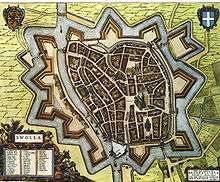
Zwolle was also, with Deventer, one of the centers of the Brethren of the Common Life, a monastic movement. 5 km (3 mi) from Zwolle, on a slight eminence called the Agnietenberg, (hill of St Agnes), once stood the Augustinian convent in which Thomas à Kempis spent the greatest part of his life and died (in 1471).[11]
At least as early as 1911, Zwolle had a considerable trade by river, a large fish market, and the most important cattle market in the Netherlands after Rotterdam. The more important industries comprised cotton manufactures, iron works, boat-building, dyeing and bleaching, tanning, rope-making, and salt-making.[11]
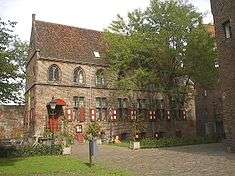
In World War II, Zwolle was single-handedly liberated from the Germans by French Canadian soldier Léo Major.[12] He was made an honorary citizen of Zwolle in 2005 and a street is named for him.
In 2004, Zwolle's De Librije restaurant was honored with 3 stars by Michelin Guide; as of 2018, it is one of only three restaurants so honored in the entire country.
Blauwvingers
Citizens of Zwolle are colloquially known as Blauwvingers (Bluefingers). This dates back to 1682, when the St Michael's church tower collapsed. The authorities were strapped for cash and saw no option but to sell the church bells to neighbouring city Kampen. To make sure that Kampen would not make too much profit from the deal, the local authorities asked a high price for the church bells. Kampen accepted, yet after the arrival of the bells it became clear, they were too damaged to be played. In revenge, Kampen paid in copper coins of four duiten (the equivalent of two-and-a-half cents). Zwolle distrusted Kampen and wanted to be sure they truly paid the entire price. After the rigorous counting of this vast amount of money, their fingers had turned blue from the counting of money.[13][14]
Geography

Besides the Grote or Sint Michaëlskerk (the latter which houses a majestic Baroque organ built by Arp Schnitger), there are several other historic monuments in Zwolle. The Roman Catholic Onze Lieve Vrouwe ten Hemelopneming-basilica (Our Lady Ascension) dates back to 1399. The church tower, called Peperbus (pepperbox), is one of the tallest and most famous church towers in the Netherlands. The modernized town hall was originally built in 1448.[11]
Mention should also be made of the Sassenpoort (one of the old city gates), the city walls, the Mosterdmakerstoren (mustard makers' tower)(the complex where local mustard used to be made), a guild-house (1571), the former provincial government offices, a Dominican monastery, and on the Melkmarkt, two museums; the Stedelijk Museum Zwolle of antiquities and natural history, and the Vrouwenhuis. Museum de Fundatie, the fine art museum of the province of Overijssel, is hosted in the former Justice Hall on Blijmarkt Square.
In the western part of the city, west of the railway station, there is a quarter of Art Nouveau buildings, concentrated mostly on Koningin Wilhelminastraat, Prinses Julianastraat, and Prins Hendrikstraat. These three-store living houses were built in 1900s by various Dutch architects. Eleven of the buildings are protected by the Dutch government (rijksmonumenten).
The Broerenkerk church was part of the Dominican monastery founded in 1465. The monastery was closed in 1580 and the monks were expelled. From 1640 until 1982 the church was used for Protestant services. After a restoration in 1983–1988 it has been used for cultural events and it is now a bookstore.[15][16]
Image gallery
 Thorbeckegracht
Thorbeckegracht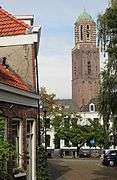 Peperbus from the Eekwal. The house in front really is that crooked.
Peperbus from the Eekwal. The house in front really is that crooked.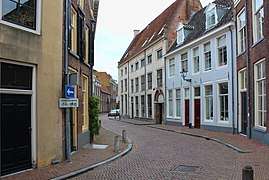 Praubstraat, inner city
Praubstraat, inner city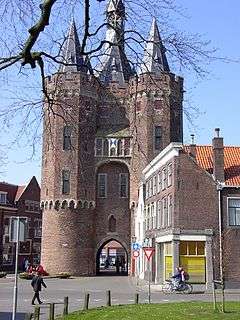 Sassenpoort
Sassenpoort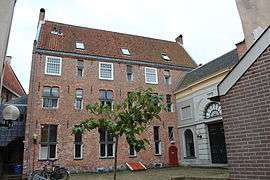 The Rich Friar House a center of the Devotio Moderna and later the home of Willem Bartjens
The Rich Friar House a center of the Devotio Moderna and later the home of Willem Bartjens Zicht op Zwolle Centrum
Zicht op Zwolle Centrum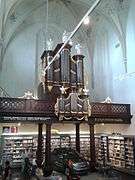 The organ in Broerenkerk
The organ in Broerenkerk The Art Nouveau gate at Prins Hendrikstraat 1-3-5. 1902, architect Geurt Gijsbertus Post
The Art Nouveau gate at Prins Hendrikstraat 1-3-5. 1902, architect Geurt Gijsbertus Post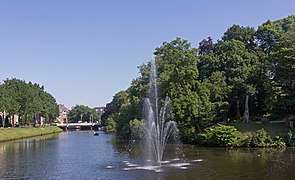 Fountain near Museum de Fundatie
Fountain near Museum de Fundatie
Notable residents
- See also People from Zwolle
- Arts, culture, entertainment and the media
- Hein Boele (born 1939), actor, Dutch voice of Elmo[17]
- Jonnie Boer (born 1965), chef with three Michelin stars
- Gerard ter Borch (1617–1681), painter[18]
- Tooske Breugem (born 1974), television host actress[19]
- Herman Brood (1946–2001), painter/rock star
- Marnix Kappers (1943–2016), actor[20]
- Master I. A. M. of Zwolle (c. 1440–1490), engraver
- Ton Koopman (born 1944), a conductor, organist, and harpsichordist
- Yuri Landman (born 1973), experimental musical instrument builder, comic book artist
- Michael Minsky (1918–1988), singer and conductor
- Leonard van Munster (born 1972), artist
- Opgezwolle, (since 2001) rap crew
- Jan Vayne (Jan Veenje) (born 1966), pianist
- Charlotte Wessels, (born 1987) singer for Delain
- Authors
- Eef Brouwers (born 1939), journalist and former head of the Netherlands Government Information Service
- A. den Doolaard (1901–1994), author
- Rhijnvis Feith (1753–1824), author
- Everhardus Johannes Potgieter (1808–1875), author
- Religion
- Johannes Busch (1399-ca.1480), church reformer and provost of the Augustinian monastic order
- Andreas Ignatius Schaepman (1815–1882), Archbishop of Utrecht
- Alanus de Rupe (1428–1475), Roman Catholic theologian and Dominican promotor of the rosary
- Politics
- Laurens Jan Brinkhorst (born 1937), former Minister of Economic Affairs
- Joan van der Capellen tot den Pol (1741–1784) role in the Batavian Republic
- Willem Johan Lucas Grobbée (1822–1907), Minister of Finance from 1883 to 1885
- Johan Rudolf Thorbecke (1798–1872), Prime Minister of the Netherlands (1849/1853, 1862/1866, 1871/1872)[21]
- Sports
- Jeroen Dubbeldam (born 1973), 2000 Olympic Equestrian champion
- Marten Eikelboom (born 1973), hockey player
- Martin Haar (born 1952), former football defender and current trainer
- Ron Jans (born 1958), former football player and current coach
- Eric Pierik (born 1959), field hockey player
- Johannes Smeekens (born 1987), Olympic speedskater
- Peter Wessels (born 1978), tennis player.
- Science
- Christianus Carolus Henricus van der Aa (1718–1793) Secretary of the Royal Holland Society of Sciences and Humanities
- Thomas Joannes Stieltjes (1856–1894), mathematician, civil engineer and politician
- Derk-Jan Dijk (Born 1958), Researcher of sleep and circadian rhythms
Educational institutions
Zwolle is home to several universities and colleges:
- Artez
- Christelijke Hogeschool Windesheim
- Deltion College Zwolle
- Hogeschool Zwolle
- Landstede Zwolle
- Cibap Zwolle
- Groene Welle Zwolle
- Hogeschool viaa
- Thorbecke Scholengemeenschap
- nl:Thorbecke Scholengemeenschap
- Windesheim Honours College
Transport
Road transport
Zwolle is a hub in the national highway network, and gateway to northern Netherlands. This is reflected in the high traffic volumes in and around the city. The A28 serves Zwolle with 4 exits, and runs from Utrecht to Groningen. It is being widened to 8 lanes across the IJssel River and 6 lanes from Zwolle to Meppel in 2010 and 2011. The motorway initially opened between 1964 and 1970.[22] Another motorway, the A50, interchanges with A28 just west of the city, offering a route for southbound traffic to Apeldoorn and Eindhoven.
The N35 highway starts in Zwolle, where it forms the eastern section of the ring road of Zwolle, it runs as a non-motorway to Almelo and continues to Enschede as A35 motorway. The ringroad is mainly a 4-lane road, with numerous traffic lights. It forms a full ring, and also exists out of the N337 highway that runs to Deventer. Other sections of the ring road are not numbered. Parts of the ring road were widened to six lanes in 2010. Other numbered highways running from Zwolle are N331 to Hasselt, N758 to Nieuwleusen, N340 to Ommen and N764 to Kampen.
Bridges
Due to nearby rivers, there are several major bridges in and around Zwolle. The most important bridge is the IJssel Bridge where the A28 motorway runs across. It was completed in 1970 and carries over 125.000 vehicles per day. Adjacent to this bridge is the older IJssel Bridge, which opened in 1930 and was destroyed twice during World War II. A third IJssel Bridge is the railway bridge (called Hanze boog) which carries the railway line from Zwolle to Amersfoort, and from 2012, to Lelystad. There are several bridges across the Zwarte Water River, including two 4-lane bridges, a 2-lane bridge, and a bus/bicycle bridge. There is also a bridge across the Vecht, which carries A28 motorway. Another local bridge is adjacent to this bridge. A third bridge carries rail traffic to Leeuwarden and Groningen. Numerous local bridges exist around the historic city center.
Rail transport
The first train in Zwolle arrived on 6 June 1864. Today the city has rail connections in eight directions (viz. Kampen, Leeuwarden, Groningen, Emmen, Enschede, Arnhem/Nijmegen, Lelystad/Amsterdam, and Amersfoort).
The rail connection with Amsterdam via Lelystad – the Hanzelijn – is operational since December 2012.
The second station, Zwolle Stadshagen, was opened on 15 December 2019.
Water transport
Zwolle is located on or near three rivers (Zwarte Water, Vecht, and IJssel), several canals (the now disused Willemsvaart, Nieuwe Vecht and Overijssels Kanaal and the modern Zwolle-IJssel Kanaal). There are some water-related industries in Zwolle, mainly in the Voorst industrial area.
International relations
Twin towns—sister cities
Zwolle is currently twinned with:

In the past, Zwolle had partnerships with:

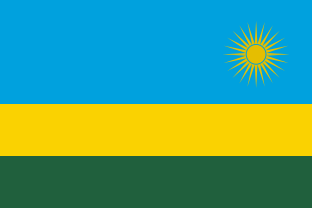


References
- "Portefeuille burgemeester Peter Snijders" [Tasks of mayor Peter Snijders] (in Dutch). Gemeente Zwolle. Retrieved 6 October 2019.
- "Kerncijfers wijken en buurten" [Key figures for neighbourhoods]. CBS Statline (in Dutch). CBS. 2 July 2013. Retrieved 12 March 2014.
- "Postcodetool for 8011PK". Actueel Hoogtebestand Nederland (in Dutch). Het Waterschapshuis. Retrieved 25 March 2014.
- "Bevolkingsontwikkeling; regio per maand" [Population growth; regions per month]. CBS Statline (in Dutch). CBS. 1 January 2019. Retrieved 1 January 2019.
- "Bevolkingsontwikkeling; regio per maand" [Population growth; regions per month]. CBS Statline (in Dutch). CBS. 26 June 2014. Retrieved 24 July 2014.
- Theo Holleman (1996), Een verleden op de schop, University Press, Amsterdam, ISBN 90-5356-189-7
- Hove, ten J. (2005). Geschiedenis van Zwolle Zwolle: Waanders. ISBN 90-400-9050-5
- F.C. Berkenvelder (1980). "Het begin". Zwolle 750 jaar stad (in Dutch). Waanders. Archived from the original on 16 August 2006. Retrieved 17 March 2007.
- F.C. Berkenvelder (1980). "De handel en de Hanze". Zwolle 750 jaar stad (in Dutch). Waanders. Retrieved 17 March 2007.
De stedelijke geldmiddelen, het nationaal inkomen zouden wij nu zeggen, die in 1402 nog 6.000 gulden bedroegen waren in 1450 bijna verzesvoudigd tot 34.000 gulden. (Translated: The city's financial resources, the national income as we would now call it, which were 6,000 guilders in 1402, had by 1450 multiplied by six to 34,000 guilders.)
- "Zwolle op keerpunt van bestaan" (in Dutch). De Stentor. 2 March 2005.
-

- https://www.britannica.com/biography/Leo-Major
- Boxma, Willem (2001). "Steuren, blauwvingers, kwekweschudders en tukkers. Schimpnamen in Overijssel". Traditie. Tijdschrift over tradities en trends. (in Dutch). 2: 26–27. ISSN 1382-4104.
- "In welke stad wonen de blauwvingers?" (in Dutch). Nederlands Centrum voor Volkscultuur. Archived from the original on 11 January 2006. Retrieved 21 March 2007.
- "Zwolle (Ov): Broerenkerk". archimon.nl. Retrieved 10 August 2013.
- Scholten, Rick. "Waanders in the Broerenkerk". Retrieved 10 August 2013.
- IMDb Database retrieved 11 February 2020
- . Encyclopædia Britannica. 26 (11th ed.). 1911.
- IMDb Database retrieved 11 February 2020
- IMDb Database retrieved 11 February 2020
- . Encyclopædia Britannica. 26 (11th ed.). 1911.
- "completion dates A28 at autosnelwegen.nl".
Literature
- Lourens, Piet; Lucassen, Jan (1997). Inwonertallen van Nederlandse steden ca. 1300–1800. Amsterdam: NEHA. ISBN 9057420082.CS1 maint: ref=harv (link)
External links
| Wikisource has the text of the 1911 Encyclopædia Britannica article Zwolle. |
- . Encyclopædia Britannica. 28 (11th ed.). 1911.


- Official website
